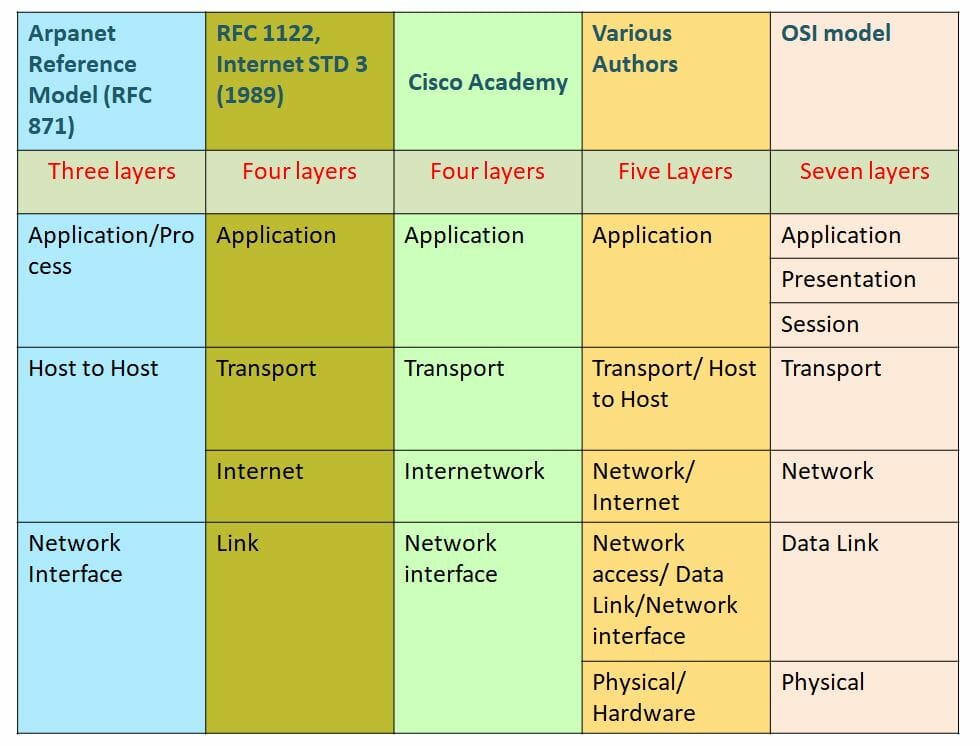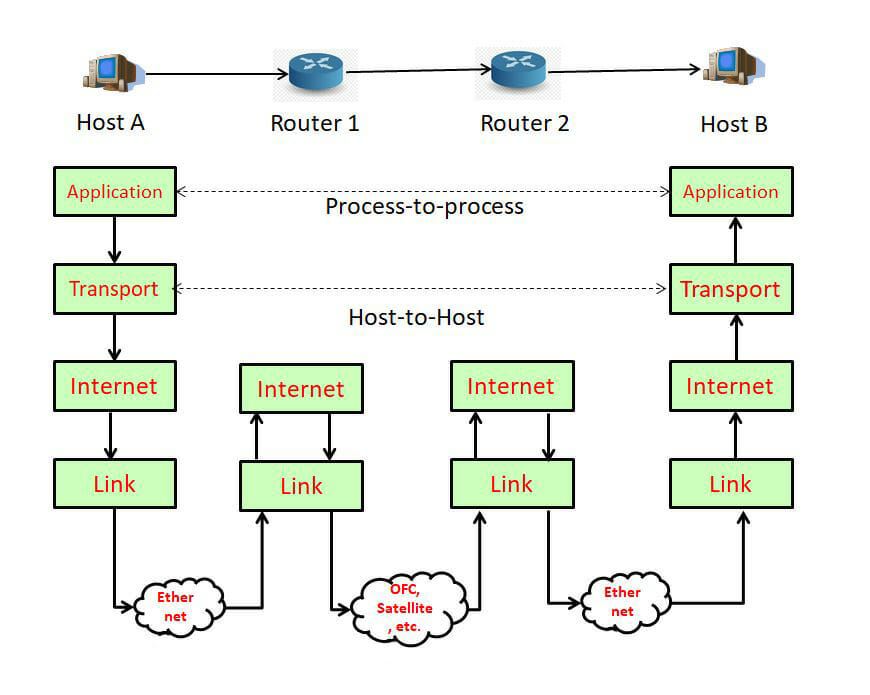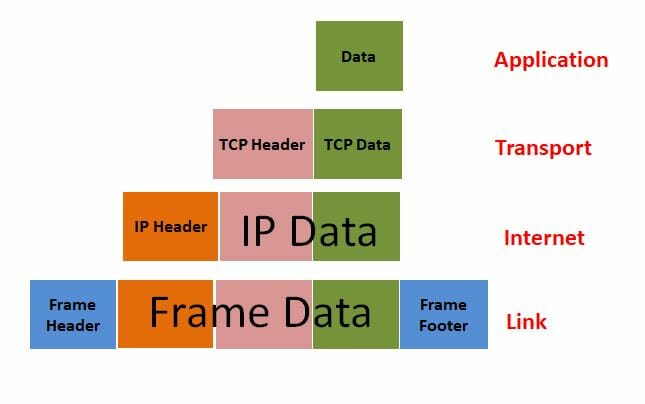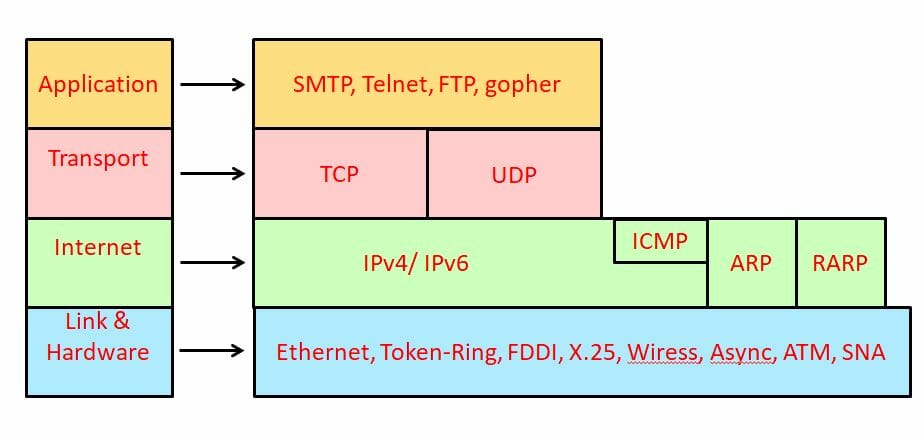The TCP/IP protocol suite: Introduction
The Internet protocol suite or the TCP/IP protocol suite is the driving force for the Internet and networks worldwide. Its simplicity and strength have led to its becoming the only network protocol of today’s Internet world. In this blog, we give a summary of the TCP/IP protocol suite.
The name of the TCP/IP protocol suite acquires its origin from two principal protocols, i.e., Transmission controlled protocol (TCP) and the Internet Protocol (IP). TCP is a transport layer protocol, and the IP holds the command of the Internet layer. Another term used for this standard is the Internet Protocol Suite, which is though a less common term.
The history of TCP/IP starts with the research of the DARPA in the late ’60s. Since then, it has undergone various changes in protocols and standards. Officially the currently used version of TCP/IP was implemented from 1st Jan 1983. For details of history, kindly refer to the topic Introduction and brief history of the network.
The primary purpose of the Internet protocol suite was to interconnect heterogeneous networks. An internetwork is the network of interconnected networks, geographically apart of each other. The TCP/IP is the arrangement to provide a common, reliable, and universal communication between them.
The Internet consists of the following combination of networks:
- Backbones are large networks that interconnect smaller networks. They are known as Network Access Points (NAPs), or the Internet eXchange Points (IXPs).
- Regional networks that connect, for example- the Universities and colleges of different cities.
- The ISPs or commercial networks are the paid services that provide access to IPX, NAP backbones to the customer.
- Local networks like LAN, CAN, etc.
Different standards and naming conventions
The following figure shows the comparative chart of the layers constituting a TCP/IP model. The Internet-standard 3 of 1989 vide RFC 1122 and the Cisco academy explains it in a four-layer model. However, some famous authors in their books have defined the five layers of TCP/IP. Here we shall follow the official standard of the four-layer model.
There is a slight difference in naming conventions of the layers, though all the names mentioned in the chart generally used interchangeably.

The Application, Presentation, and the Session layer of the OSI reference model form a single layer as the Application layer. The transport layer remains unchanged, also referred to as the host-to-host layer in some write-ups.
The third OSI layer performs here as the Internet layer, Internetwork layer, or Network layer itself. The data link and the physical layer of the seven-layer model collectively known as the link-layer or the network interface layer. In some books, the link-layer is shown separately from the physical layer, making it a five-layer architecture is also referred to as the network interface layer. The physical layer or the hardware layer functions in combination with the 2nd layer as the link layer.
Hence, the four layers of TCP/IP protocol suits are:
- Application layer.
- Transport or host-to-host layer.
- The internet layer, aka Internetwork layer, aka Network layer.
- The link-layer, aka network access layer, aka Network Interface layer.
Function of the layers
The data flow between two nodes A and B connected through intermediate routers is shown in the figure below. The application layer of each node interacts as if they are connected horizontally. This layer seems to be unaware of the connection mechanism provided by the lower layers.
Or, we can say the Application layer of end hosts communicate seamlessly once the connection is established. Similarly, the transport layer communicates as host-to-host communication without having the idea of routing and addressing stuff being handled by the lower layers.
Let’s examine the role of each layer briefly.

Application Layer
The application layer is concerned with the application and the processes. It is the user process that creates the user data and communicates with other applications with the user data. The other application may be at the other end or in the same host. A few examples of application processes are FTP, SMTP, HTTP, SSH, Telnet, etc.
The interface between the application layer and the transport layer is handled by the port numbers. The application layer makes use of the services of lower layers, especially the transport layer that provides reliable or unreliable communication.
You may find the term datagram frequently while studying the protocol stacks. Let me clear the concept of the term datagram first.
Datagrams are the primary data units, comprising of a header and a payload. The datagrams in different layers are different. For example, the datagram in the transport layer is a segment that in the network layer is a packet, and in the link-layer, it’s a frame. The method of accomodating data payloads in the header is encapsulation.
Transport Layer
The transport layer provides end-to-end data transfer by delivering data on the remote host. The remote host may be a part of a local network or not. The host belonging to the other networks is communicated with the help of the intermediate routers.
The transport layer supports multiple processes from the application layer.
The transport layer supports connection-oriented as well as connectionless communication. The transmission Controlled Protocol (TCP) is the protocol for connection-oriented communication in the transport layer. The TCP provides connection-oriented, reliable data-delivery.
It also performs tasks like duplicate data suppression, congestion control, and flow control.
The protocol divides the entire message into smaller segments and adds a TCP header to them. The receiver sends an acknowledgment for each data segment. The unacknowledged segments are retransmitted for error recovery. The TCP also suppresses the data segments which are duplicate.
UDP is another transport layer protocol, which is a connectionless and faster one. It is a connectionless, unreliable, best-effort delivery protocol. UDP is more effective in the services where speed is a primary concern, and that can bear a few packet losses.
Internet Layer
The Internet layer also called the Network layer, or the Internetwork layer virtually represents the network. The network lower than this cannot see the higher layers. This layer exchanges the packets across the network. The role of this layer is to provide the addressing and the routing function primarily.
The primary protocol used in this layer is another component of the TCP/IP protocol suite, The Internet Protocol (IP). IP is a connectionless protocol, which does not provide reliability, flow control, or error recovery. The upper layers oversee these functions.
The IP attempts to deliver the datagrams from source to destination by routing function. It routes the IP datagrams or the packets across the network boundaries.
The other protocols of the Interner layer are ICMP, IGMP, ARP, RARP, etc.

Link Layer
In the TCP/IP protocol suite, a link-layer is the actual interface to the network hardware. The other names of this layer are the Network access layer, or network interface layer. This layer may or may not provide reliable communication.
The Internet protocol suite does not specify any protocol in this layer indeed. Hence, it has the flexibility to use almost any protocol at this layer. The famous protocols used in this layer are Ethernet, Wi-Fi, ATM, Frame Relay, FDDI, SNA, etc.
The link-layer provides communication between the local links without any intermediate routers. This layer includes the hardware implementation for the TCP/IP protocol suite. Its functions are framing, transmitting of frames, translate network address to the link-layer address, etc.
The datagram of the link-layer is a frame. The link-layer adds a header and a trailer to each frame. The transmission from one link-layer to another link-layer over the same network segment is guided via the physical address (MAC address).
Apart from the physical layer characteristics, the link-layer is also responsible for the implementation of the virtual link like the Virtual Private Network (VPN).
The various protocols of TCP/IP protocol suite

Application Layer
HTTP (HyperText Transfer Protocol)– A foundation protocol for data distribution in the World Wide Web. The hyperlinked files you browse in the Network by clicking the links are the HTTP implementations.
HTTPS(HTTP Secure)– An extension of HTTP for secure communication. You may have noticed a green pane in the browser address bar as an indication of a secure site.
FTP(File Transfer Protocol)– A standard protocol for transferring files on the Network.
Telnet– A protocol for remote logging a host with a text-based interface and bi-directional communication utilizing virtual terminal communication.
SSH (Secure Shell)– An encrypted method of remote logging, generally used for remote command execution in a device.
SMTP (Simple Mail Transfer Protocol)– Standard protocol for sending emails.
POP (Post Office Protocol): Protocol for receiving the emails. The commonly used version is POP-3.
SNMP (Simple Network Management Protocol)– A protocol for managing devices in a network. The network devices like a router, switch, firewalls, etc. managed from a centralized console.
DNS (Domain Name System)– Protocol for a domain name to IP address resolution.
Transport Layer
TCP (Transmission Controlled Protocol)-It is One of the transport layer protocols. TCP is a connection-oriented and reliable protocol used in TCP/IP protocol suite.
UDP(User Datagram Protocol)-Another well-known transport layer protocol. It is connectionless, unreliable, and suitable for real-time applications.
Internet Layer
IPv4 and IPv6 (Internet Protocol v4 & v6)– IP is the network layer protocol for logical addressing and routing the packets over the networks.
ICMP (Internet Control Message Protocol): It is a supporting protocol in the IP layer. It is used for displaying the error messages, indicating the connection status, etc. The examples are Ping, tracert, etc. commands. ICMPv6 is the implementation of ICMP in IPv6.
IPSec (Internet Protocol Security): It is a security add-on upon IPv4 and an integrated part of IPv6. The mechanism for encrypting the packets over an IP network. Also, the base of the secure connection like a Virtual Private Network (VPN).
IGMP(Internet Group Management Protocol)-Mostly used by the routers to manage the multicast groups in IPv4.
ARP(Address Resolution Protocol)– Protocol for mapping network to link-layer. It is used to get the MAC-address for a known IP address.
RARP(Reverse Address Resolution Protocol)– Reverse of ARP, a protocol used for mapping MAC address to an IP address. ARP sends IP to get MAC, whereas RARP sends MAC to get IP.
Link-Layer
PPP (Point to Point Protocol)- PPP itself is a network layer protocol, but two extensions of PPP, viz. PPPoE and PPPoA, PPP over Ethernet, and PPP over ATM are link layer protocols for encapsulating PPP frames into Ethernet, and ATM respectively. These protocols are used by ISPs to deliver DSL lines.
SLIP(Serial Line Internet Protocol)- Encapsulation of IP over serial lines. It is mostly replaced by PPP.
LLDP (Link Layer Discovery Protocol)- Protocol used by network devices for advertising their various parameters. It is mostly used for network monitoring and management.
DLCI (Data Link Connection Identifier)-Identification of the virtual circuit used by Frame Relay.
HDLC(High-Level Data Link Control)-An extension of IBM’s SLDC (Synchronous Data Link Control) used in SNA (Systems Network Architecture). Allows transmission of frames over a synchronous or asynchronous serial link.
Network Interfaces
Ethernet (IEEE 802.3)
Wi-Fi (IEEE 802.11)
Frame Relay
FDDI (Fiber Distributed Data Interface)
Frame Relay
X.25
Token Ring
Token Bus
Take a Quiz on this topic :
<br><br><br>

